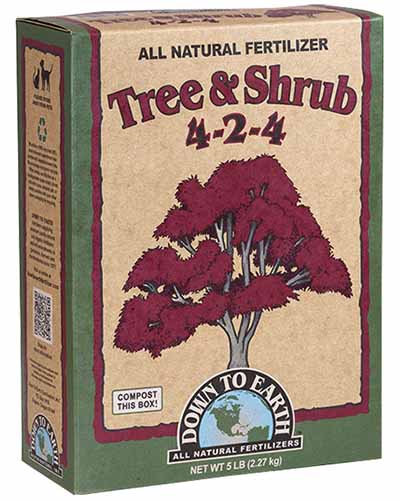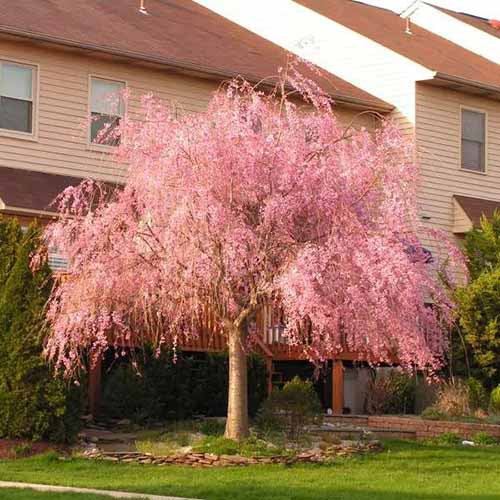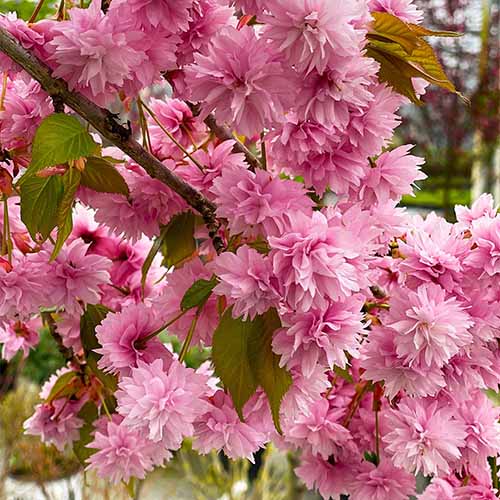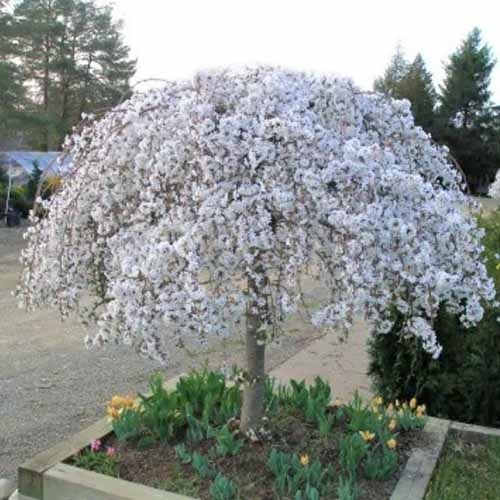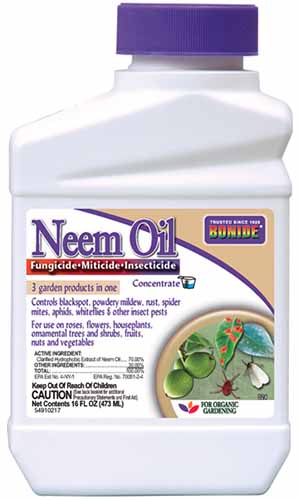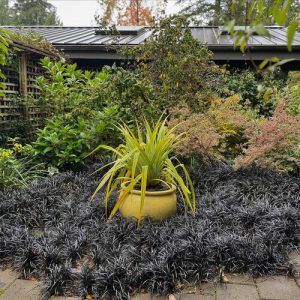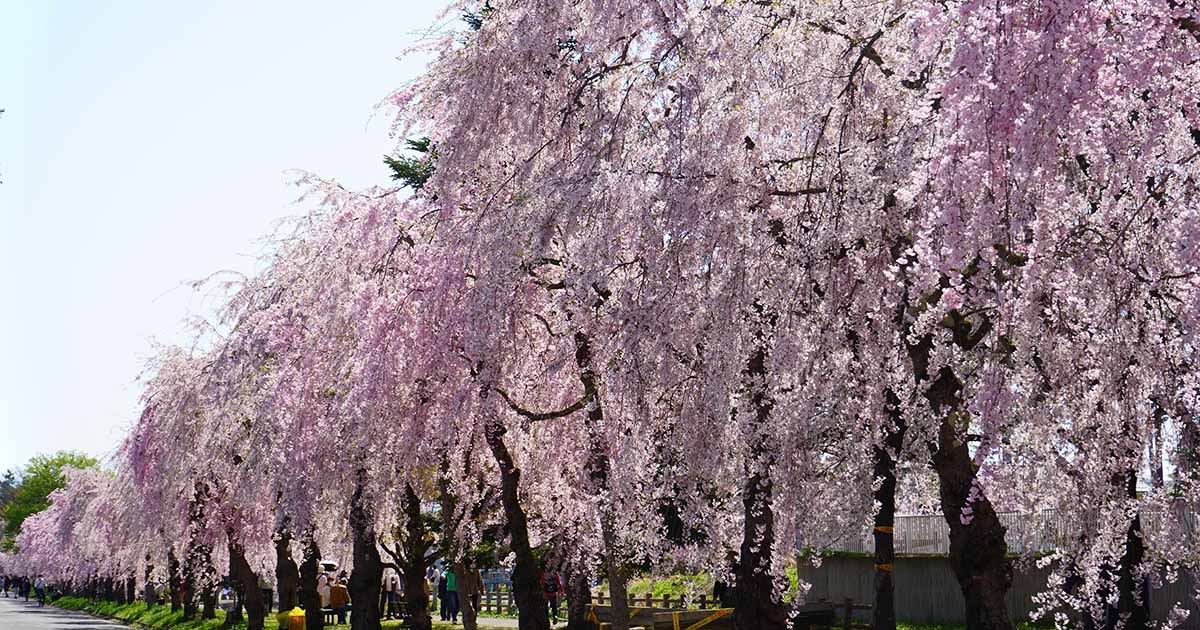
Prunus spp.
Looking for a pendulous twist on an old favorite? Then a weeping cherry tree may be just what you need.
Much of the time, drooping plant shoots mean that something’s wrong. But for weeping cherry trees, such droopage is normal. Actually, it’s better than normal – it’s flat-out gorgeous.
There’s something very captivating about a cherry tree’s “weepiness.”
Perhaps it symbolizes finding beauty in crestfallen sadness, or maybe it’s a reminder to stand tall, even when the world is bringing you down – its aesthetic can inspire many different takeaways.

We link to vendors to help you find relevant products. If you buy from one of our links, we may earn a commission.
It also looks natural, yet unnatural at the same time, in a way that’s delightfully uncanny.
Much like a photorealistic tattoo, a celebrity wax statue, or the animation style of “The Polar Express,” a drooping yet healthy growing habit looks like it shouldn’t even be, yet it is.
Metaphors and comparisons aside, these trees look quite cool. But for maximum coolness, they must be grown correctly. And to do that, you’ll need the right know-how.
That’s what this guide is for. All the cultivation knowledge you need, right at your fingertips.
Here’s what I’ll cover:
What Are Weeping Cherry Trees?
A weeping cherry tree is any variety of flowering cherry tree with soft, limp twigs, pendulous branches, and an overall cascading appearance.
Native to Japan, China, and Korea, these plants flaunt a lovely east Asian aesthetic. I’d describe the vibe as “samurai movie backdrop,” which, coming from a nerd, is the highest of praise.

For the most part, they’re hardy in USDA Zones 5 to 8, although some varieties can grow a bit outside this range.
The true weeping form doesn’t occur much in nature, as most trees described as “weeping” are cultivated varieties that are selected for their weeping forms, which originally occurred as a result of genetic mutations.
To create these plants, plantsmen typically graft weeping cherry tree scions to four- to five-foot tall rootstocks of upright cherry trees.
Belonging to the Rosaceae family, the scions of weeping cherry trees come from many different Prunus species and hybrids: P. serrulata, Prunus x subhirtella, and Prunus x yedoensis are a few notable ones.
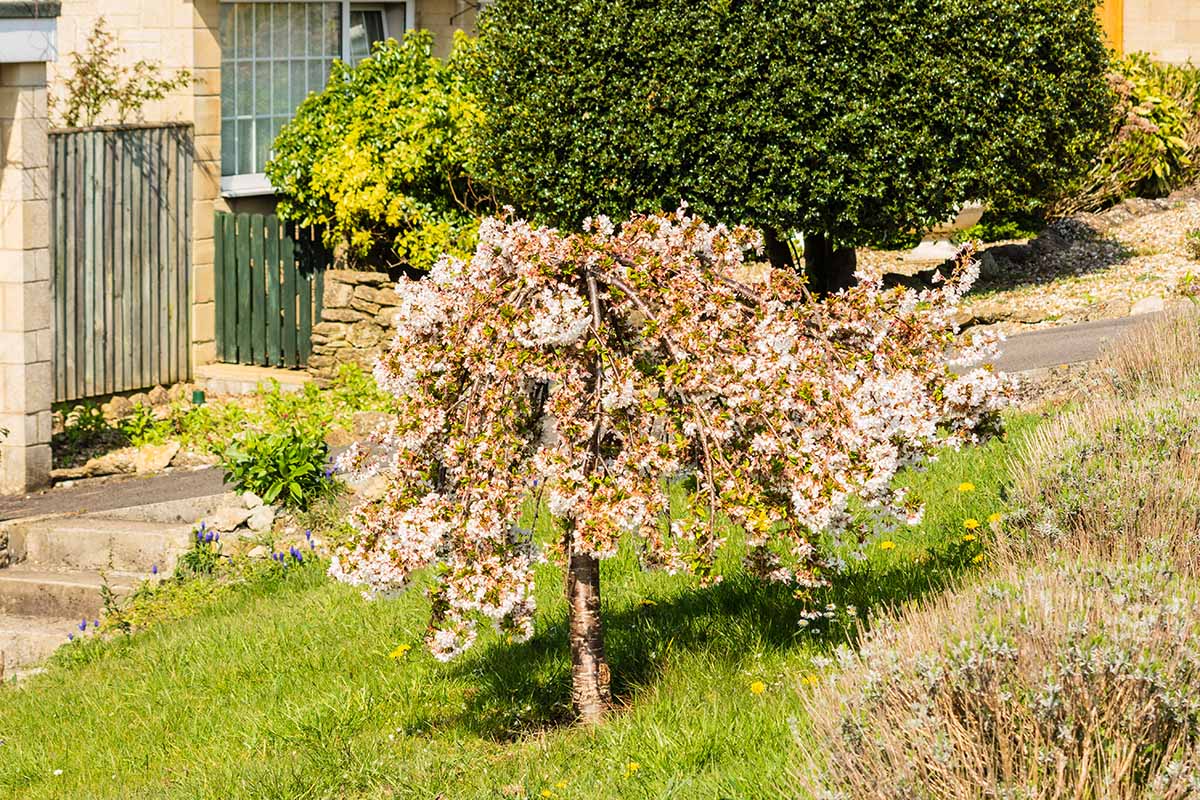
These plants can grow six to 30 feet tall and five to 25 feet wide, as they are available in both dwarf and full-sized varieties.
Flaunting oval-shaped green leaves with tapered points and serrated edges, these trees burst with single or double, white to pink flowers in spring, which attract bees, butterflies, and hummingbirds.
After pollination, the tree produces black to red drupes, which are much smaller and less tasty than those of cherry trees that are actually grown for their fruits. But they’re still quite tasty to birds and herbivorous woodland critters!
Weeping Cherry Propagation
As I mentioned, weeping cherry trees are cultivated via grafting. However, these techniques can be difficult for a novice to pull off correctly, and are a bit beyond the scope of this guide.
You could propagate via cuttings, but if you do so, you wouldn’t have the desirable traits of the rootstock. Our guide to growing ornamental flowering cherry trees provides the necessary steps.
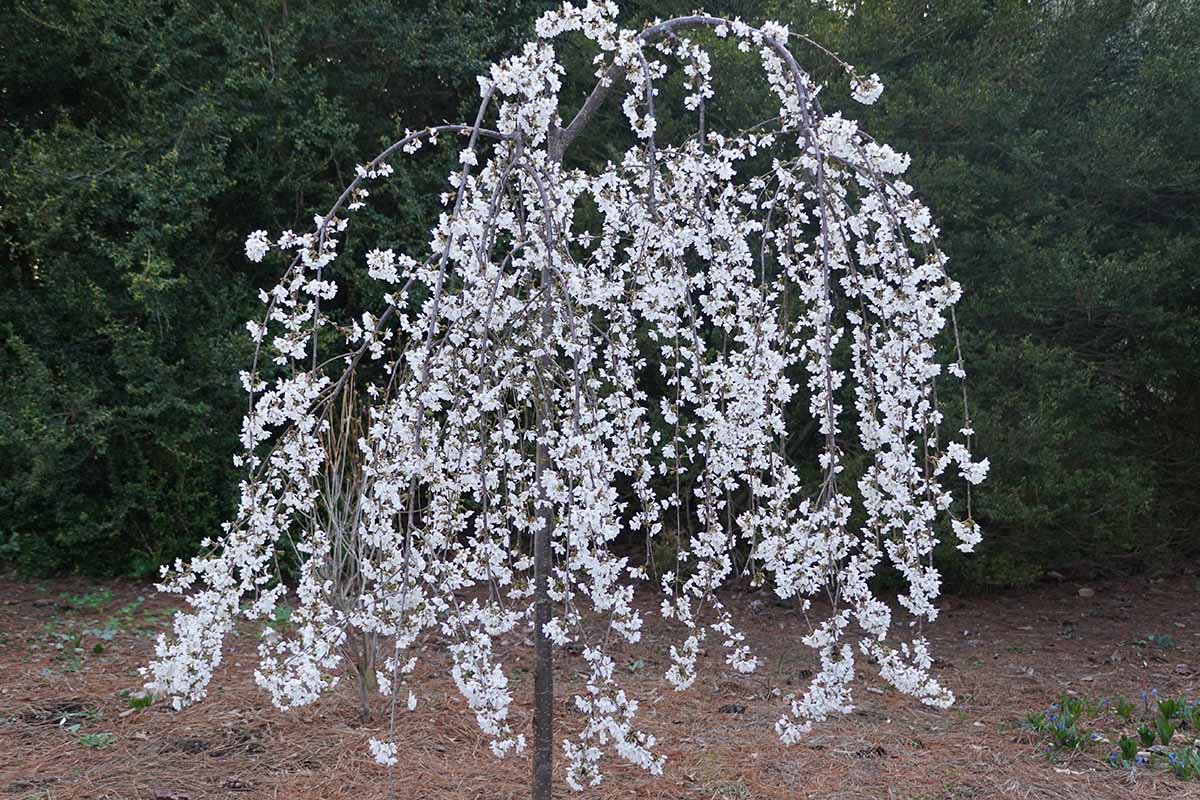
To get started with your own weeping cherry tree, I’d suggest purchasing a sapling from a reputable nursery for transplant into your garden.
The best time to transplant is in early spring after the final frost, so plan your acquisition accordingly.
Ensure that your intended planting sites have full sun exposure. Make sure each site is spaced far enough away from other plants and structures – you want your trees to reach their full size without their branches or roots bumping into anything.
If you have bare root trees, soak their roots three to six hours before planting time. If your sapling is growing in a container, you can skip this step.
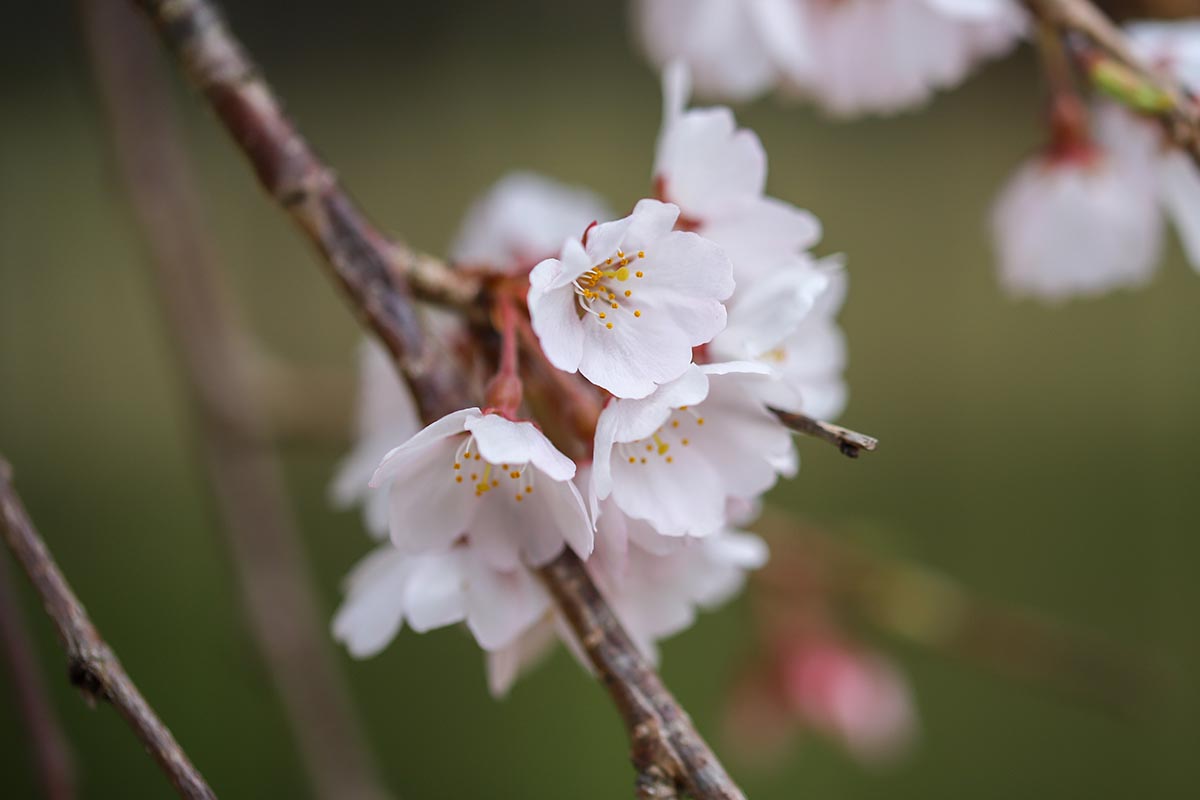
Make sure the garden soil at the planting sites is moisture-retaining yet well-draining, with a pH of 6.0 to 7.5.
Dig your planting holes twice as deep and twice wide as your transplant’s root system or the container it’s currently growing in.
Take your dug-out soil, mix it with equal parts compost, and then backfill the hole halfway.
If your sapling is in a container, gently remove it and set it in the hole, making sure it’s sitting at the same depth as it was in the original container.
For bare root transplants, create a mound of soil at the bottom of the hole, then gently spread the roots out over it, ensuring that the root collar is slightly above the soil line. Make sure the graft union is well above the soil line.
Alternate backfilling and watering to help it all settle, and when you’re done, water in your transplants to make the soil nice and moist. Congrats, you’re done!
How to Grow Weeping Cherries
With your weeping cherries in-ground, let’s learn how to keep ’em around.
Climate and Exposure Needs
For year-round survival, these plants will need to be in USDA Hardiness Zones 5 to 8, for the most part – certain varieties are suitable for slightly hotter or colder climates.

They are tolerant of heat, snow, and frost, so they’ll do just fine on the edge of their hardiness ranges.
A full sun location is best, so make sure to expose your weeping cherries to as much sunlight as possible.
Soil Needs
The perfect garden soil for a weeping cherry should be moisture-retaining, well-draining, and fertile, with a pH of 6.0 to 7.5. A loamy soil texture with ample humus is perfect.
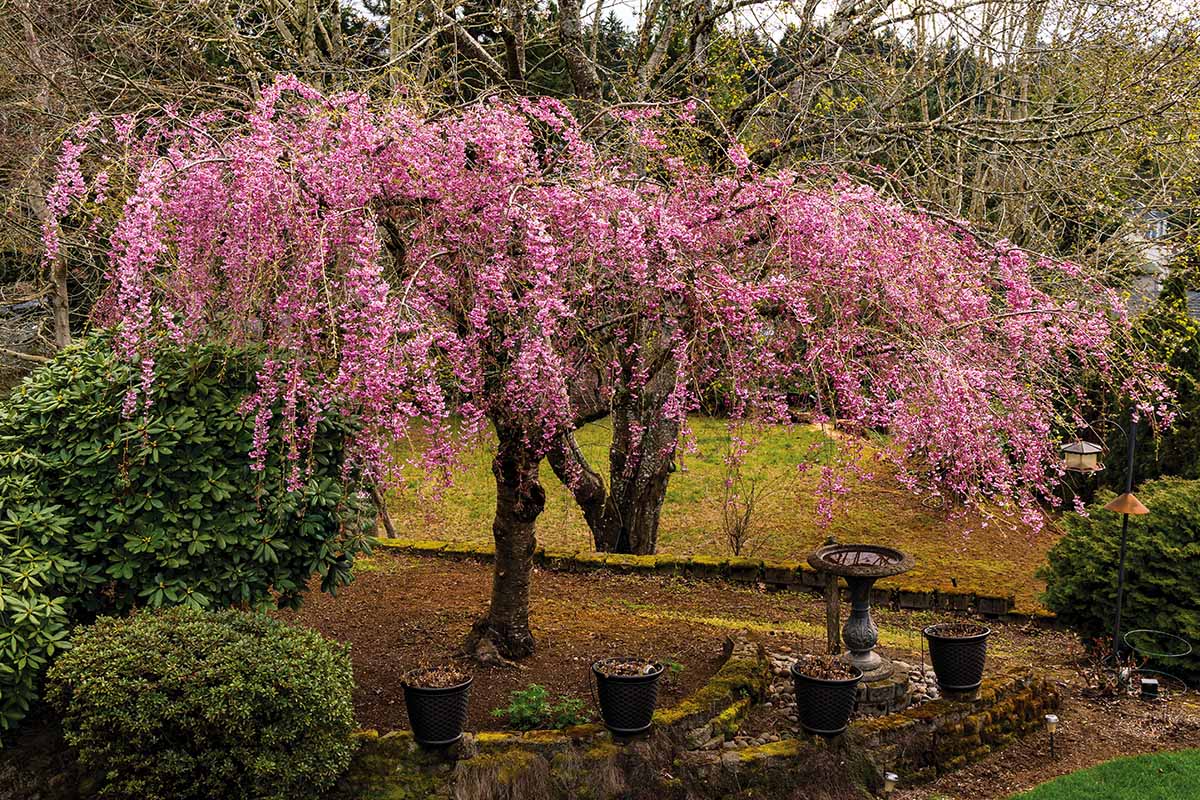
To keep the humus content up to snuff, top dress with a couple inches of compost or well-rotted manure and work it into the soil under the drip line every spring.
Water and Fertilizer Needs
Along with sunlight, consistent moisture is needed to power those beautiful blooms. To provide it, water deeply whenever the top three inches of soil dry out.
Moderate moisture is absolutely essential – these trees can’t stand drought, nor wet feet.
To encourage prolific blooming, you can apply a balanced fertilizer or one formulated for trees and shrubs once in spring.
Down to Earth Tree and Shrub Fertilizer
Use a product like Down to Earth Tree and Shrub Fertilizer, available via Arbico Organics.
Growing Tips
- Plant in a full sun location.
- Fertilize once in spring.
- Water whenever the top three inches of soil dry out.
Pruning and Maintenance
Other than any necessary pruning to maintain the weeping shape, these plants typically don’t need regular trimming.
But if you do need to give your plant a haircut, wait until just before bud break in spring, and don’t remove more than a third of the plant’s branches in the process.
Dead, damaged, and/or diseased branches can be removed whenever you notice them.
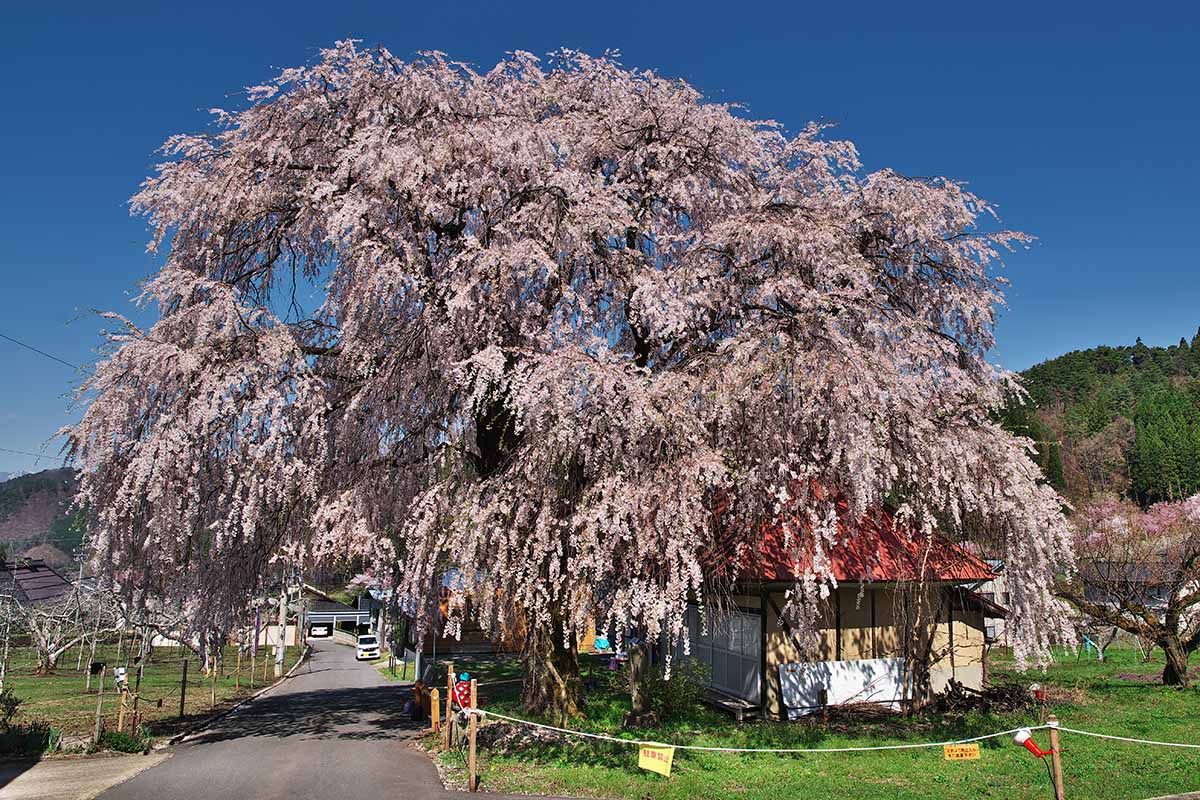
To help retain moisture, suppress weeds, and to protect the roots, it’s helpful to maintain a layer of mulch around the dripline – just make sure that the mulch is kept a couple of inches away from the trunk.
Supplemental watering should be ceased whenever temperatures dip below 40°F and/or there’s snow on the ground.
Depending on how manicured you want your garden to be, you might need to rake up the leaves after they’ve dropped in fall.
Weeping Cherry Cultivars to Select
There are numerous weeping cherry cultivars available and you should have no problem finding one that meets your aesthetic needs.
Here are five of my favorites:
Kiku-Shidare-Zakura
Prunus ‘Kiku-Shidare-Zakura’ – a Japanese flowering cherry cultivar – puts on a showstopping display, as each of its richly pink double flowers has up to 125 petals!
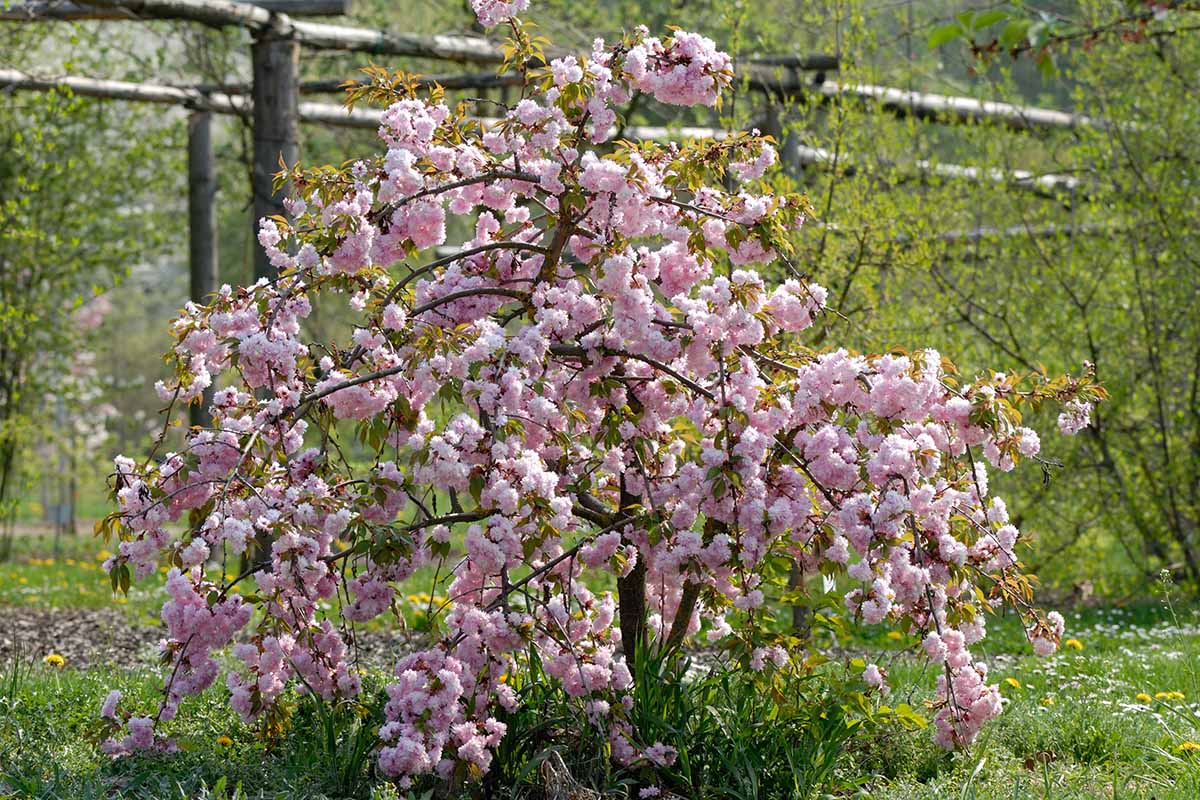
With a mature height and spread of 10 to 15 feet, ‘Kiku-Shidare-Zakura’ is a wonderful specimen planting for spots needing a relatively compact tree. It’s hardy in Zones 4 to 9.
Plena Rosea
Digging double blooms? P. subhirtella ‘Plena Rosea’ aka ‘Pendula Plena Rosea’ is another double-bloomer, with each pale pink double flower flaunting 10 to 20 twisted flower petals with a prominent red center.
Additionally, these beautiful flowers persist longer into the summer than other weeping cherries!
Hardy in Zones 5 to 8, the plant reaches a mature height and spread of 15 to 25 feet.
A bit larger than ‘Kiku-Shidare-Zakura,’ ‘Plena Rosea’ is ideal for filling out bigger planting sites.
You can find ‘Plena Rosea’ in four-by-four-by-six-inch containers available at Nature Hills Nursery.
Shidare-Yoshino
Hardy in Zones 5 to 8, Prunus x yedoensis ‘Shidare-Yoshino’ is a weeping cultivar of the famed Yoshino cherry.

Bursting with single white flowers, ‘Shidare-Yoshino’ reaches heights of 20 to 25 feet and spreads of 20 to 30 feet.
For a brilliant white mass of drooping blooms, you can’t go wrong with ‘Shidare-Yoshino.’
Weeping Extraordinaire
As if regular weeping cherry flowers weren’t extraordinary enough, Weeping Extraordinaire™ features delightful double pink blooms that are super-duper fluffy, with numerous narrow petals to give each flower a “stuffed-to-the-brim” aesthetic.
Hardy in USDA Zones 5 to 8 and with a mature height and width of 15 to 20 feet, Prunus x ‘Extrazam’ is tolerant of urban pollution, making it a perfect planting for the street or a public park.
Prunus x ‘Extrazam’ is available as a four- to five-foot transplant from FastGrowingTrees.com.
White Snow Fountains
The name pretty much covers it. With a cascading, elegant habit that bursts with stark white flowers, White Snow Fountains® really lives up to its name.
Reaching a mature height of eight to 15 feet and a spread of eight to 10 feet, Prunus x ‘Snofozam’ is a bit taller than it is wide, making it a solid accent tree for tighter spots in the landscape.
You can find White Snow Fountains® in #5 containers available at Nature Hills Nursery.
Managing Pests and Disease
Nothing gives a weeping cherry tree something to cry about quite like pests and disease. Let’s discuss how to deal with them!
Herbivores
Unfortunately, these trees can be quite susceptible to…
Voles
Sometimes known as “field mice,” voles look like the stocky, short-tailed love-children of mice and hamsters.
With their impressive speed, jumping ability, digging skills, and reproductive rates, large populations can quickly burrow around and through plant roots, as well as chew up the bark at the base of trees.
Placing vole or mouse traps around popular burrow paths and nesting sites can catch or kill these pests, depending on the traps you use.
Either way, peanut butter makes a great bait, especially if you bait the traps for vole activity in the afternoon to early evening when they are active.
Protect your tree trunks with loose tree guards made of mesh or hardware cloth. Bury the guards a bit below the soil to keep voles from squeezing inside. Fox or coyote urine works as a repellent, but those need reapplying after rain.
Insects
Since insects can vector pathogens, it’s doubly important to manage them. Especially these ones:
Borers
“Borers” refers to the immature larval stages of a variety of different moths and beetles.
After emerging from eggs laid in plants in spring to summer, borers will tunnel through living wood as they feed, which damages xylem and phloem tissues.
This feeding weakens the plant, causing girdling, dieback, and eventual death. The feeding tunnels are also prime entry points for pathogens to wreak their own havoc.
Since adult insects tend to lay their eggs in damaged, sickly, or otherwise stressed plants, proper cultivation is essential for prevention. By caring for your trees properly and not wounding them, you’re telling bugs “this ain’t a good spot!”
If borers do become a problem, you may need to apply pyrethroids or other insecticides via bark sprays. More systemic insecticides can be applied via injections or soil drenches, preferably by a professional.
Japanese Beetles
Popillia japonica is a Japanese-native species of beetle that packs quite an appetite.
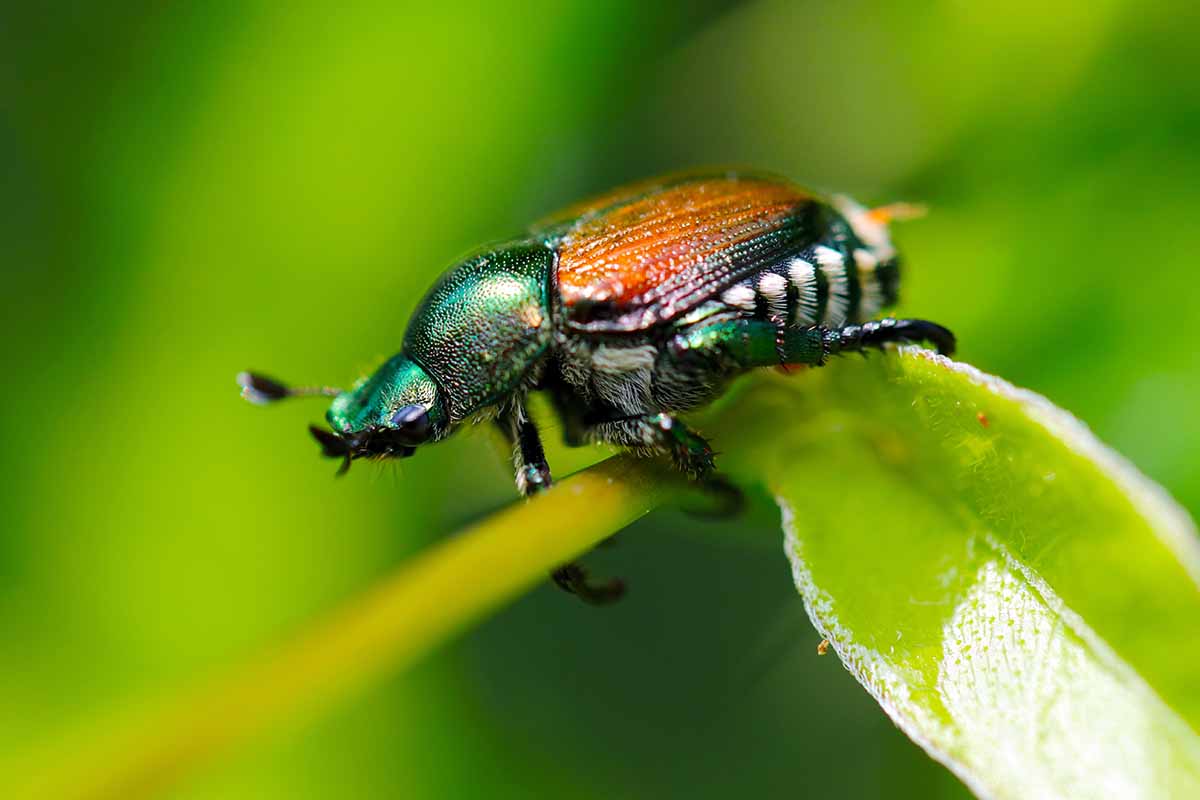
With shiny, metallic green bodies and coppery wing covers, adult Japanese beetles take conspicuous bites out of leaves and flowers, which can skeletonize leaves and hinder photosynthesis.
If these insects strike, I’d prescribe “soapy death.”
During a cool morning or evening, take a bucket of soapy water to an infested plant and flick the bugs in the water.
The soap will keep them under as they drown. A bit too grisly? Try spraying your plants with neem oil instead.
Bonide sells neem oil in ready-to-use or concentrated forms at Arbico Organics.
Learn more about how to deal with Japanese beetles in our guide.
Disease
Along with proper cultivation, sanitizing your garden tools is an easy way to prevent disease spread.
Black Knot
Caused by the fungus Apiosporina morbosa, black knot is a common and annoying disease that affects Prunus species.
The trademark symptom is the formation of hard, tumor-like galls on branches and trunks, which appear black and swollen.
Overwintering in galls from the previous year, the fungus releases spores during wet spring conditions, which spread via wind to infect the fresh shoots or wounds of other plants.
Once inside a branch or trunk, the fungus triggers the growth of masses of large plant cells, leading to the swollen galls.
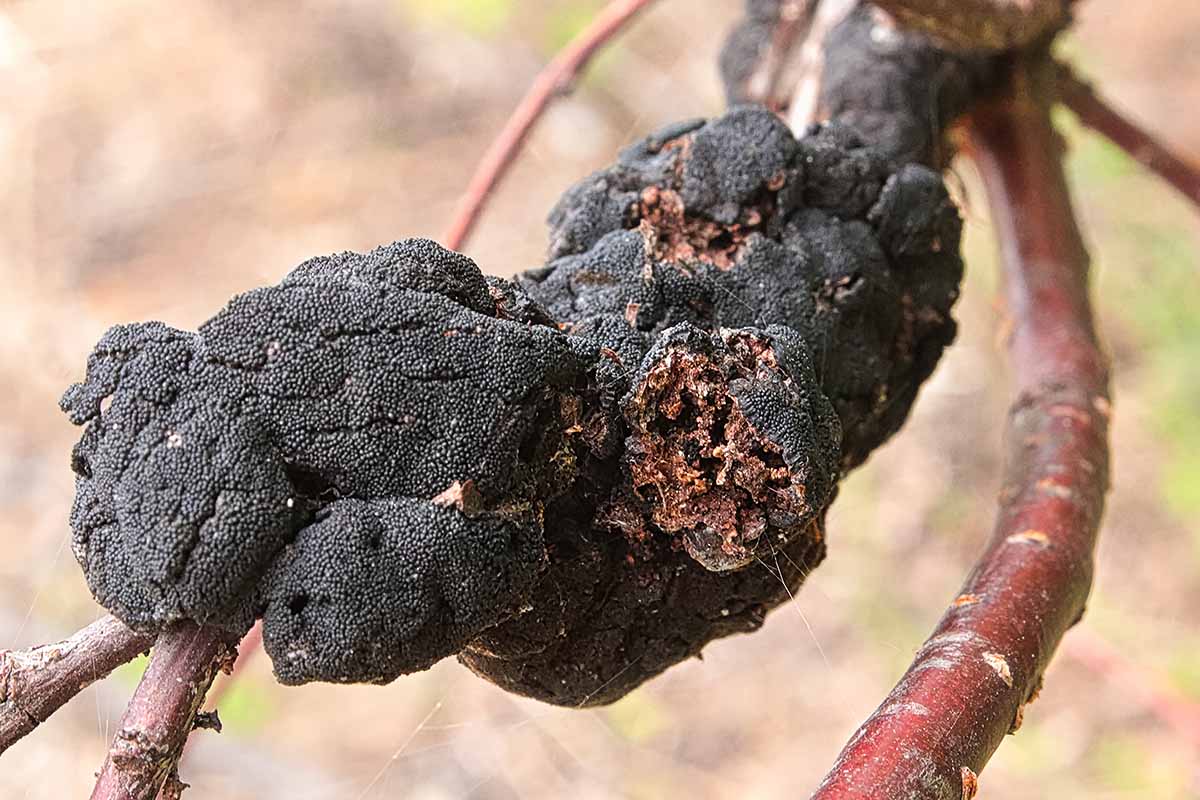
One year later, the gall is covered with a velvety, olive green fungal growth. Two years later, the gall is black, hard, and capable of releasing its own spores.
Black knot disease is tolerable, but it can distort an infected branch’s shape, kill its leaves, and crack trunk bark.
If the disease shows up on your plants, prune out the galls with sterilized tools in late winter, making your stem cuts four inches below the gall.
Burn, bury, or pitch your prunings, and don’t be afraid to remove and dispose of severely-infected plants entirely.
Cherry Shot Hole Disease
Technically, cherry shot hole disease is a symptom, rather than a true disease.
Often an eventual result of bacterial leaf spot and/or cherry leaf spot, this affliction leaves small, punched-out holes in the foliage of cherry and cherry laurel species.
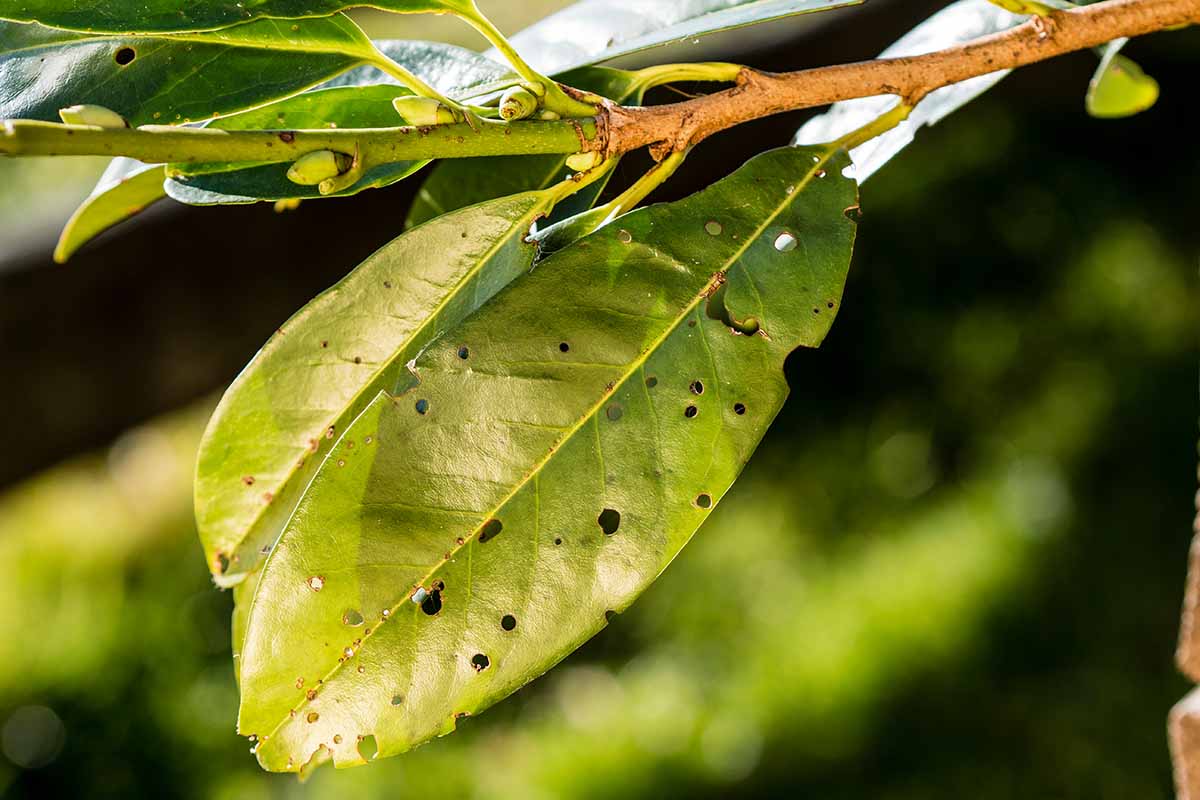
The causal diseases spread rapidly in warm, humid spring weather. In Prunus plants, afflicted leaves will eventually turn chlorotic and drop.
Space trees properly to promote good air flow to avoid a buildup of humidity, and rake up fallen leaves to prevent overwintering pathogens.
Fungicides can be used preventatively on valuable specimens, while trees heavily affected by cherry shot hole disease need to be removed entirely.
Verticillium Wilt
Verticillium wilt is a rather serious disease of Prunus that causes sudden wilting, chlorosis, necrosis, and/or brown, streaked sapwood.
After lying dormant in the soil as microsclerotia, the causal fungi Verticillium dahliae and/or Verticillium albo-atrum enters the plant through wounded roots or natural openings. It enters and clogs up the xylem, interrupting its water flow.
Plants may survive this disease without your help, but pruning dead branches, using sterilized tools, and proper cultivation all make it easier.
Since the pathogens persist in the soil indefinitely, severely infected trees should be removed and replaced with resistant plants such as arborvitae, ginkgo, or oak.
Best Uses for Weeping Cherry Trees
A weeping cherry tree is a truly delightful specimen, especially in spring when it’s in full bloom. You can plant in the vicinity of more upright trees for contrast.
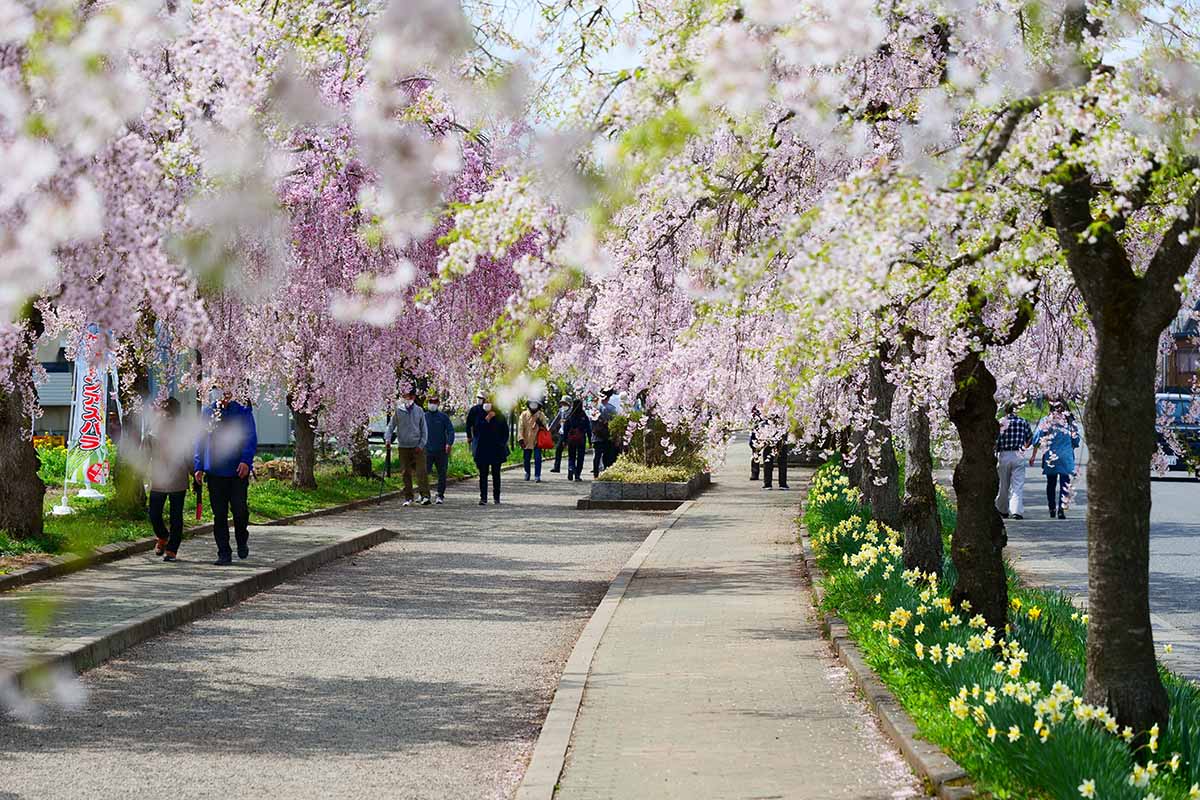
It’s also a fantastic shade tree! You may have to be a bit lower to the ground to fit comfortably under its drooping branches, perhaps lying prone or on your back… I can’t think of a better spot to take an outdoor nap, though.
Quick Reference Growing Guide
| Plant Type: | Deciduous flowering tree | Flower/Foliage Color: | Pink to white/green |
| Native to: | China, Japan, Korea | Maintenance: | Moderate |
| Hardiness (USDA Zones): | 5-8 | Water Needs: | Moderate to high |
| Bloom Time: | Spring | Tolerance: | Deer, drought (moderate), heat, poor and suboptimal soils, frost |
| Exposure: | Full sun | Soil Type: | Loose, fertile loam |
| Time to Maturity: | 5 years | Soil pH: | 6.0-7.5 |
| Spacing: | Width of mature spread | Soil Drainage: | Well-draining |
| Planting Depth: | Same depth as nursery container | Attracts: | Bees, butterflies, hummingbirds |
| Height: | 6-30 feet | Uses: | Shade tree, specimen planting |
| Spread: | 5-25 feet | Family: | Rosaceae |
| Growth Rate: | Fast | Genus: | Prunus |
| Common Pests and Diseases: | Borers, Japanese beetles, voles; black knot, cherry shot hole disease, verticillium wilt | Species: | Serrulata, x subhirtella, x yedoensis |
It’s No Ordinary Cherry…
Droopy-ness doesn’t look fantastic in people or animals, but plants like the weeping cherry really own the look. Wouldn’t you agree?
Congrats on learning the ways of these plants! May they add a delightful cascading aesthetic to your landscape for the rest of your gardening days.
Still have questions, remarks, tips of your own to share? Let us know in the comments section below!
And for more information about growing species in the Prunus genus, check out these guides next:
